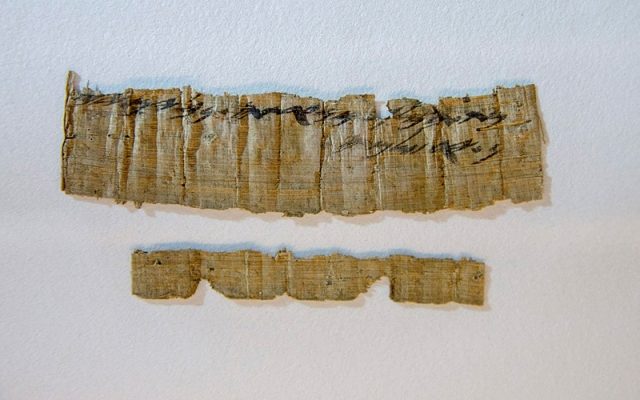Israeli archaeologists have discovered the earliest extra-biblical source to mention Jerusalem in Hebrew writing and which dates to the time of the Kingdom of Judah.
A rare and significant text written on papyrus and dating to the First Temple era, the seventh century BCE, in which the name of the city of Jerusalem is clearly mentioned, was recently uncovered during an operation initiated by the Israel Antiquities Authority’s (IAA) Unit for the Prevention of Antiquities Robbery to stop the theft of artifacts.
This is the earliest extra-biblical source to mention Jerusalem in Hebrew writing and dates to the time of the Kingdom of Judah.
The document, which was illicitly plundered from one of the Judean Desert caves by a band of antiquities robbers and was seized in a complex operation by the IAA’s Unit for the Prevention of Antiquities Robbery, was presented on Wednesday, just as UNESCO voted to deny any Jewish connection to Jerusalem.
Two lines of ancient Hebrew script were preserved on the document, which is made of paper produced from the pith of the papyrus plant.
A paleographic examination of the letters and a C14 analysis determined that the artifact is dated to the seventh century BCE – the end of the First Temple period.
Most of the letters are clearly legible using a state-of-the-art camera that was developed based on technology used by NASA, and the text reads as follows: “[me-a]mat. ha-melekh. me-Na’arta. nevelim. yia’yin. Yerushalima,” meaning “From the king’s maidservant, from Na’arat, jars of wine, to Jerusalem.”
This is a rare and original shipping document from the time of the First Temple, indicating the payment of taxes or transfer of goods to storehouses in Jerusalem, the capital city of the kingdom at the time.
The document specifies the status of the sender of the shipment, the king’s maidservant, the name of the location from which the shipment was dispatched, Na’arat, the contents of the vessels, wine, the quantity of jars sent and their destination, Jerusalem.
The town of Na’arat which is mentioned in the text is the same Na’arat that is referred to in the description of the border between Ephraim and Benjamin, just north of Jerusalem, in the Book of Joshua (16:7): “And it went down from Janohah to Ataroth, and to Na’arat, and came to Jericho, and went out at Jordan.”
Jerusalem’s Centrality Underscored
“The document represents extremely rare evidence of the existence of an organized administration in the Kingdom of Judah,” explained Dr. Eitan Klein, deputy director of the IAA’s Unit for the Prevention of Antiquities Robbery. “It underscores the centrality of Jerusalem as the economic capital of the kingdom in the second half of the seventh century BCE. According to the Bible, the kings Menashe, Amon, or Josiah ruled in Jerusalem at this time; however, it is not possible to know for certain which of the kings of Jerusalem was the recipient of the shipment of wine.”
Israel Prize laureate and biblical scholar Prof. (Emeritus) Shmuel Achituv attested to the scientific importance of the document. “It’s not just that this papyrus is the earliest extra-biblical source to mention Jerusalem in Hebrew writing; it is the fact that to date no other documents written on papyrus dating to the First Temple period have been discovered in Israel, except one from Wadi Murabba’at. Also outstanding in the document is the unusual status of a woman in the administration of the Kingdom of Judah in the seventh century BCE.”
“Organic material, such as documents, particularly delicate paper like papyrus, perish over time due to their sensitivity to moisture. The dry climate of the desert is exceptional in that it facilitates the preservation of documents that provide invaluable information regarding the way of life in antiquity and the early development of religions,” Amir Ganor, director of the IAA’s Unit for the Prevention of Antiquities Robbery, explained. “The rarity of the finds and their importance are the reasons why the antiquities robbers risk their lives coming to dig in the caves in the desert cliffs.”
He expressed his pleasure that the IAA was fortunate to have a role in saving the papyrus, which is “an important and special find that bears witness to the historical relationship between the Land of Israel and Jerusalem, and the Jewish people.”
‘Tremendous Importance’ to Israel’s Heritage
“The discovery of the papyrus shows that there are other artifacts of tremendous importance to our heritage that are waiting to be found in the Judean Desert caves,” stated Israel Hasson, director of the IAA. “The world’s heritage assets are being plundered on a daily basis by antiquities robbers solely for greed.” He called on the state to mobilize and allocate the necessary resources in order to embark upon “a historic operation,” together with the public, to carry out systematic excavations in all of the Judean Desert caves, which may probably contain further such treasures.
“The discovery of the papyrus on which the name of our capital Jerusalem is written is further tangible evidence that Jerusalem was and will remain the eternal capital of the Jewish people,” said Israel’s Minister of Culture and Sport Miri Regev. She pointed out that the discovery exposes “the deceit of false propaganda as is once again happening today in UNESCO.”
She vowed that the Temple Mount, “the very heart of Jerusalem and Israel, will remain the holiest place for the Jewish people, even if UNESCO ratifies the false and unfortunate decision another ten times.”
By: Aryeh Savir, World Israel News





